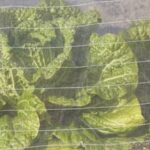Can treated wood contaminated vegetable gardens and potentially pose a risk to human health? Many people use treated wood for building raised beds and garden structures in their vegetable gardens without realizing the potential for contamination. In this article, we will explore the use of treated wood in vegetable gardens and its potential impact on soil and the vegetables grown within it.
Treated wood is a common choice for gardeners looking to build durable and long-lasting structures, such as raised beds, due to its resistance to decay and insects. However, the chemicals used in the treating process can leach into the soil over time, posing a potential risk to the plants and vegetables that grow in it.
In this article, we will delve into what treated wood is and the chemicals used in its treatment, as well as exploring the potential contaminants that can leach into the soil. Additionally, we will discuss the implications for human health of consuming vegetables grown in contaminated soil.
Furthermore, we will examine the environmental impact of using treated wood in vegetable gardens and offer alternative materials for building garden structures to avoid contamination. Stay tuned as we uncover the risks associated with using treated wood in vegetable gardens and provide recommendations for safe gardening practices.
What Is Treated Wood
Treated wood refers to lumber that has been protected from decay and insect damage through the application of chemical preservatives. The process involves impregnating the wood with these preservatives under high pressure to ensure deep penetration and long-lasting protection. The most commonly used chemicals for treating wood include chromated copper arsenate (CCA), alkaline copper quaternary (ACQ), and copper azole (CA), among others.
One of the most traditional methods of treating wood is pressure treatment, which involves placing the wood in a sealed cylinder and applying vacuum pressure to remove air and moisture from the wood cells. Then, the preservative is pumped into the cylinder under pressure, which forces it deep into the wood fibers. This process ensures that the entire piece of lumber is treated, providing comprehensive protection against decay and insects.
The chemicals used in treated wood have different properties, but generally work by either making the wood toxic or repelling insects and fungi. Chromated copper arsenate (CCA) was once commonly used for treating outdoor wood structures such as decks and playground equipment due to its effectiveness.
However, concerns about its potential health and environmental risks led to its phase-out in residential applications around 2004. In response, alternative compounds like alkaline copper quaternary (ACQ) were developed as safer alternatives for treating wood while still providing effective protection against decay and pests.
| Treated Wood Chemical | Preservative Properties |
|---|---|
| Chromated Copper Arsenate (CCA) | Makes wood toxic to insects and fungi |
| Alkaline Copper Quaternary (ACQ) | Repels insects and fungi without being toxic |
| Copper Azole (CA) | Protects against decay and insect damage without leaching into soil |
Potential Contaminants
Treated wood is often used in vegetable gardens for building raised beds, fences, and garden structures due to its durability and resistance to decay. However, the chemicals used in the treatment process can potentially leach into the soil, posing a risk of contaminating the vegetables grown in the garden. It is important for gardeners to understand the potential contaminants in treated wood and take necessary precautions to avoid any health or environmental risks.
Chemicals Used in Treated Wood
The process of treating wood involves infusing it with chemicals that protect it from decay and insect damage. Common chemicals used in this process include chromated copper arsenate (CCA), creosote, and pentachlorophenol (PCP). These chemicals are effective at preserving wood but can also pose a risk of leaching into the surrounding soil over time, especially when exposed to moisture.
Potential Contamination of Vegetables
When these chemicals leach into the soil, there is a possibility that they can be taken up by the plants growing in the garden. This means that vegetables such as carrots, potatoes, and other root crops can potentially absorb these contaminants, leading to their presence in the edible parts of the plant. Consuming vegetables that have been contaminated with these chemicals can pose serious health risks.
Precautionary Measures
In order to prevent contamination from treated wood, it is important to use a barrier between the treated wood and the soil if it must be used for garden structures. This could include using a plastic liner or creating a double-walled construction with an inner layer made from safer untreated wood.
Additionally, selecting alternative materials for building raised beds such as cedar or composite lumber can also help reduce the risk of contamination. Regular testing of soil for chemical levels can also help detect any contamination early on.
By understanding the potential contaminants in treated wood and taking necessary precautions, gardeners can minimize the risk of contaminating their vegetable gardens with hazardous chemicals.
Risks to Human Health
Treated wood has been used for many years in construction and landscaping, including for building raised beds and other structures in vegetable gardens. However, there is growing concern about the potential risks of using treated wood in areas where food is grown, specifically due to the chemicals used in the treatment process. These chemicals can leach into the soil and potentially contaminate the vegetables grown in these gardens.
The process of treating wood involves impregnating it with preservatives to protect it from decay, fungi, insects, and other environmental stressors. The most common chemicals used in this process are chromated copper arsenate (CCA), creosote, and pentachlorophenol (PCP). CCA was widely used until 2003 when it was phased out for residential purposes due to concerns about its arsenic content. Creosote and PCP are still permitted for use but are less commonly used today.
When these chemicals leach into the soil, they can be taken up by the plants, leading to potential health risks for humans who consume contaminated vegetables. Arsenic exposure has been linked to various health issues such as skin lesions, developmental effects, cardiovascular disease, neurotoxicity, and diabetes. Likewise, exposure to creosote or PCP can have serious health effects on humans if ingested over time.
| Chemical | Health Risks |
|---|---|
| Chromated Copper Arsenate (CCA) | Skin lesions, developmental effects, cardiovascular disease |
| Creosote | Cancer risk, respiratory issues |
| Pentachlorophenol (PCP) | Liver and kidney damage |
Environmental Impact
Treated wood has been widely used in construction, including for building raised beds and garden structures. While it is durable and resistant to decay, there is a growing concern about the potential contamination of the surrounding environment. When treated wood leaches chemicals into the soil, it can have a detrimental impact on the ecosystem.
The environmental impact of treated wood contamination on the surrounding environment can include:
- Soil contamination: Chemicals such as arsenic, chromium, and copper used in treated wood can leach into the soil, affecting its composition and potentially harming plants and microorganisms.
- Water pollution: Leaching chemicals from treated wood can also contaminate nearby water sources such as groundwater or surface water bodies, posing a risk to aquatic life.
- Air pollution: As treated wood breaks down over time, it can release harmful chemicals into the air, contributing to air pollution in the surrounding area.
To mitigate the environmental impact of treated wood contamination in vegetable gardens, it is crucial to consider alternative materials for construction. Using natural untreated wood, composite materials, or recycled plastic lumber can provide durable and safe alternatives for building raised beds and garden structures without introducing harmful chemicals into the environment. Additionally, proper disposal of old treated wood materials is essential to prevent further contamination of landfills or other waste disposal sites.
In order to safeguard the surrounding environment from potential contamination caused by treated wood, it is vital for gardeners and homeowners to be aware of the risks and take proactive measures to make environmentally conscious choices when constructing or renovating their vegetable gardens.
Alternatives to Treated Wood
Untreated Wood
One alternative to using treated wood in vegetable gardens is to utilize untreated wood. Untreated wood, such as cedar or redwood, can be a more natural and safe option for building raised beds or garden structures. These types of wood are naturally resistant to decay and rot, making them suitable for outdoor use without the need for chemical treatment.
Composite Materials
Another alternative to treated wood is the use of composite materials. Composite lumber is made from a combination of wood fibers and plastic, providing a durable and low-maintenance option for garden structures. This material does not require chemical treatment and can withstand outdoor conditions, making it a safe choice for use in vegetable gardens.
Natural Stone or Brick
For a more permanent solution, natural stone or brick can be used to construct raised beds or garden structures. These materials do not pose any risk of contamination and provide excellent durability. While they may require a higher initial investment, they offer long-term stability and an attractive aesthetic for the garden.
By utilizing these alternative materials, gardeners can avoid the potential risks associated with using treated wood in their vegetable gardens. When choosing materials for building raised beds or garden structures, it’s important to consider longevity, cost, and environmental impact to make the best decision for the health and safety of both the plants and the individuals consuming them.
Testing and Remediation
When it comes to ensuring the safety of your vegetable garden, testing soil for potential contamination is crucial. Whether you have used treated wood in the past or are unsure of the history of your garden beds, testing the soil can provide valuable information about the presence of harmful chemicals.
There are various methods available for testing soil, including DIY test kits and professional laboratory analysis. DIY test kits can provide a quick assessment of soil pH and basic nutrient levels, while professional laboratory analysis can offer more comprehensive results, including the presence of specific contaminants from treated wood.
In the event that your soil tests positive for contamination from treated wood, there are several methods for remediation. One option is to remove and replace the affected soil with clean, uncontaminated soil. This may involve removing existing plants and starting fresh with new topsoil.
Another method for treating contaminated areas is through the use of phytoremediation, which involves planting certain species of plants that have the ability to absorb and detoxify contaminants from the soil. In some cases, adding amendments such as activated charcoal or biochar to the soil can help mitigate contamination by binding with harmful chemicals.
In addition to addressing contaminated soil directly, it’s important to consider preventing further contamination in your vegetable garden. This may involve using alternative materials for building raised beds or garden structures, such as untreated wood, composite lumber, or galvanized metal. By taking proactive steps to test for contamination and remediate affected areas, you can ensure a safe and healthy environment for growing vegetables in your garden.
Conclusion
In conclusion, while the use of treated wood in vegetable gardens may seem like a convenient and cost-effective option for building raised beds and garden structures, it also comes with potential risks of contamination. The chemicals used in the treating process, such as arsenic, copper, and chromium, can leach into the soil and pose a threat to human health when consumed through contaminated vegetables. Additionally, the environmental impact of treated wood contamination on surrounding ecosystems should not be overlooked.
To minimize these risks, it is important for gardeners to consider alternative materials for their gardening projects, such as untreated natural wood, cedar, or composite lumber. These materials offer safer options for constructing raised beds and garden structures without the risk of chemical contamination. Additionally, regular testing of soil in vegetable gardens can help identify any potential contamination from treated wood and prompt remediation measures to ensure a safe growing environment for vegetables.
In light of these potential risks, it is crucial for gardeners to prioritize safe gardening practices by thoroughly researching the materials they use in their gardens and staying informed about potential hazards. By taking proactive steps to avoid using treated wood and regularly testing soil for contaminants, gardeners can create a safe and healthy environment for growing vegetables without compromising on the quality or safety of their harvests.
Frequently Asked Questions
Is Treated Wood Safe for Vegetable Gardens?
Treated wood, typically pressure-treated with chemicals to prevent rot and insect damage, can potentially be harmful to vegetable gardens. The chemicals used in the treatment process, such as chromated copper arsenate (CCA) or creosote, may leach into the soil and be absorbed by the vegetables, posing a risk to human health.
Does Treated Wood Leach Chemicals Into the Soil?
Yes, treated wood has the potential to leach chemicals into the soil. Over time, the preservatives used in treated wood can break down and release toxic substances into the surrounding soil. This leaching process can result in the accumulation of harmful chemicals in the soil, which can then be taken up by plants and eventually consumed by humans.
Is Home Depot Pressure Treated Wood Safe for Vegetable Gardens?
While Home Depot does offer pressure-treated wood products for outdoor use, caution should be exercised when using these materials in vegetable gardens. It is important for consumers to be aware of the type of treatment used on the wood sold at Home Depot and whether it is safe for use in close proximity to edible plants.
It is recommended to seek alternative options for constructing raised beds or other garden structures if safety concerns arise regarding pressure-treated wood from Home Depot.

If you’re looking to get into vegetable gardening, or are just looking for some tips on how to make your current garden better, then you’ve come to the right place! My name is Ethel and I have been gardening for years. In this blog, I’m going to share with you some of my best tips on how to create a successful vegetable garden.





